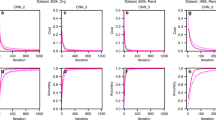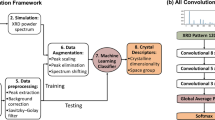Abstract
Powder X-ray diffraction analysis is a critical component of materials characterization methodologies. Discerning characteristic Bragg intensity peaks and assigning them to known crystalline phases is the first qualitative step of evaluating diffraction spectra. Subsequent to phase identification, Rietveld refinement may be employed to extract the abundance of quantitative, material-specific parameters hidden within powder data. These characterization procedures are yet time-consuming and inhibit efficiency in materials science workflows. The ever-increasing popularity and propulsion of data science techniques has provided an obvious solution on the course toward materials analysis automation. Deep learning has become a prime focus for predicting crystallographic parameters and features from X-ray spectra. However, the infeasibility of curating large, well-labeled experimental datasets means that one must resort to a large number of theoretic simulations for powder data augmentation to effectively train deep models. Herein, we are interested in conventional supervised learning algorithms in lieu of deep learning for multi-label crystalline phase identification and quantitative phase analysis for a biomedical application. First, models were trained using very limited experimental data. Further, we incorporated simulated XRD data to assess model generalizability as well as the efficacy of simulation-based training for predictive analysis in a real-world X-ray diffraction application.



Similar content being viewed by others
Data and code availability
Data is available upon request.
References
Dinnebier RE, Billinge SJ (2008) Powder diffraction: theory and practice. R Soc Chem 25:87
Pecharsky V, Zavalij P (2009) Fundamentals of powder diffraction and structure characterization of materials
Gates-Rector S, Blanton T (2019) The powder diffraction file: a quality materials characterization database. Powder Diffr 34(4):352–360
Lutterotti L, Pilliere H, Fontugne C, Boullay P, Chateigner D (2019) Full-profile search-match by the rietveld method. J Appli Crystallogr 52(3):587–598
Rietveld HM (1967) Line profiles of neutron powder-diffraction peaks for structure refinement. Acta Crystallogr 22(1):151–152
McCusker L, Von Dreele R, Cox D, Louër D, Scardi P (1999) Rietveld refinement guidelines. J Appl Crystallogr 32(1):36–50
Oviedo F, Ren Z, Sun S, Settens C, Liu Z, Hartono NTP, Ramasamy S, DeCost BL, Tian SI, Romano G et al (2019) Fast and interpretable classification of small x-ray diffraction datasets using data augmentation and deep neural networks. Comput Mater 5(1):1–9
Mao SS, Burrows PE (2015) Combinatorial screening of thin film materials: An overview. J Materiomics 1(2):85–91
Sun S, Hartono NT, Ren ZD, Oviedo F, Buscemi AM, Layurova M, Chen DX, Ogunfunmi T, Thapa J, Ramasamy S et al (2019) Accelerated development of perovskite-inspired materials via high-throughput synthesis and machine-learning diagnosis. Joule 3(6):1437–1451
de Pablo JJ, Jackson NE, Webb MA, Chen L-Q, Moore JE, Morgan D, Jacobs R, Pollock T, Schlom DG, Toberer ES et al (2019) New frontiers for the materials genome initiative. Comput Mater 5(1):1–23
Agrawal A, Choudhary A (2019) Deep materials informatics: applications of deep learning in materials science. Mrs Commun 9(3):779–792
Choudhary K, DeCost B, Chen C, Jain A, Tavazza F, Cohn R, Park CW, Choudhary A, Agrawal A, Billinge SJ et al (2022) Recent advances and applications of deep learning methods in materials science. Comput Mater 8(1):1–26
Park WB, Chung J, Jung J, Sohn K, Singh SP, Pyo M, Shin N, Sohn K-S (2017) Classification of crystal structure using a convolutional neural network. IUCrJ 4(4):486–494
Vecsei PM, Choo K, Chang J, Neupert T (2019) Neural network based classification of crystal symmetries from x-ray diffraction patterns. Phys Rev B 99(24):245120
Aguiar JA, Gong ML, Tasdizen T (2020) Crystallographic prediction from diffraction and chemistry data for higher throughput classification using machine learning. Computational Materials Science 173:109409
Zaloga AN, Stanovov VV, Bezrukova OE, Dubinin PS, Yakimov IS (2020) Crystal symmetry classification from powder x-ray diffraction patterns using a convolutional neural network. Mater Today Commun 25:101662
Lee J-W, Park WB, Lee JH, Singh SP, Sohn K-S (2020) A deep-learning technique for phase identification in multiphase inorganic compounds using synthetic xrd powder patterns. Nat Commun 11(1):1–11
Wang H, Xie Y, Li D, Deng H, Zhao Y, Xin M, Lin J (2020) Rapid identification of x-ray diffraction patterns based on very limited data by interpretable convolutional neural networks. J Chem Inf Model 60(4):2004–2011
Lee J-W, Park WB, Kim M, Singh SP, Pyo M, Sohn K-S (2021) A data-driven xrd analysis protocol for phase identification and phase-fraction prediction of multiphase inorganic compounds. Inorganic Chem Front 8(10):2492–2504
Maffettone PM, Banko L, Cui P, Lysogorskiy Y, Little MA, Olds D, Ludwig A, Cooper AI (2021) Crystallography companion agent for high-throughput materials discovery. Nat Comput Sci 1(4):290–297
Szymanski NJ, Bartel CJ, Zeng Y, Tu Q, Ceder G (2021) Probabilistic deep learning approach to automate the interpretation of multi-phase diffraction spectra. Chem Mater 33(11):4204–4215
Chitturi SR, Ratner D, Walroth RC, Thampy V, Reed EJ, Dunne M, Tassone CJ, Stone KH (2021) Automated prediction of lattice parameters from x-ray powder diffraction patterns. J Appl Crystallogr 54:6
Dong H, Butler KT, Matras D, Price SW, Odarchenko Y, Khatry R, Thompson A, Middelkoop V, Jacques SD, Beale AM et al (2021) A deep convolutional neural network for real-time full profile analysis of big powder diffraction data. Comput Mater 7(1):1–9
Bunn JK, Han S, Zhang Y, Tong Y, Hu J, Hattrick-Simpers JR (2015) Generalized machine learning technique for automatic phase attribution in time variant high-throughput experimental studies. J Mater Res 30(7):879–889
Park SY, Son B-K, Choi J, Jin H, Lee K (2022) Application of machine learning to quantification of mineral composition on gas hydrate-bearing sediments, ulleung basin, korea. J Petroleum Sci Eng 209:109840
Qian X, Wan J, Xu J, Liu C, Zhong M, Zhang J, Zhang Y, Wang S (2022) Epidemiological trends of urolithiasis at the global, regional, and national levels: a population-based study. Int J Clin Pract 2022:54
Mirković M, Dosen A, Erić S, Vulić P, Matović B, Rosić A (2020) Phase and microstructural study of urinary stones. Microchem J 152:104429
Daudon M, Dessombz A, Frochot V, Letavernier E, Haymann J-P, Jungers P, Bazin D (2016) Comprehensive morpho-constitutional analysis of urinary stones improves etiological diagnosis and therapeutic strategy of nephrolithiasis. Comptes Rendus Chimie 19(11–12):1470–1491
Pearle MS, Goldfarb DS, Assimos DG, Curhan G, Denu-Ciocca CJ, Matlaga BR, Monga M, Penniston KL, Preminger GM, Turk TM et al (2014) Medical management of kidney stones: Aua guideline. J Urol 192(2):316–324
Turk C, Neisius A, Petřík A, Seitz C, Thomas K, Skolarikos A, (2020) European Association of Urology Guidelines. 2020 Edition., vol. presented at the EAU Annual Congress Amsterdam 2020, european association of urology guidelines. 2020 edition. EAU Guidelines on Urolithiasis 2020. The European Association of Urology Guidelines Office,
Greasley J, Goolcharan S, Andrews R (2022) Quantitative phase analysis and microstructural characterization of urinary tract calculi with x-ray diffraction rietveld analysis on a caribbean island. J Appl Crystallogr 55:1
Schubert G (2006) Stone analysis. Urol Res 34(2):146–150
Daudon M, Jungers P, Bazin D, Williams JC (2018) Recurrence rates of urinary calculi according to stone composition and morphology. Urolithiasis 46(5):459–470
Lutterotti L, Matthies S, Wenk H (1999) Maud: a friendly java program for material analysis using diffraction, IUCr: Newsletter of the CPD, 21(14-15),
Ong SP, Richards WD, Jain A, Hautier G, Kocher M, Cholia S, Gunter D, Chevrier VL, Persson KA, Ceder G (2013) Python materials genomics (pymatgen): a robust, open-source python library for materials analysis. Comput Mater Sci 68:314–319
Gražulis S, Chateigner D, Downs RT, Yokochi A, Quirós M, Lutterotti L, Manakova E, Butkus J, Moeck P, Le Bail A (2009) Crystallography open database-an open-access collection of crystal structures. J Appl Crystallogr 42(4):726–729
Toby BH, Von Dreele RB (2013) Gsas-ii: the genesis of a modern open-source all purpose crystallography software package. J Appl Crystallogr 46(2):544–549
Pedregosa F, Varoquaux G, Gramfort A, Michel V, Thirion B, Grisel O, Blondel M, Prettenhofer P, Weiss R, Dubourg V et al (2011) Scikit-learn: machine learning in python. J Mach Learn Res 12:2825–2830
Suzuki Y, Hino H, Hawai T, Saito K, Kotsugi M, Ono K (2020) Symmetry prediction and knowledge discovery from x-ray diffraction patterns using an interpretable machine learning approach. Sci Rep 10(1):1–11
Freund Y, Schapire RE (1997) A decision-theoretic generalization of on-line learning and an application to boosting. J Computer Syst Sci 55(1):119–139
Author information
Authors and Affiliations
Corresponding author
Ethics declarations
Conflict of interest
The authors have no conflicts of interest to disclose.
Ethical approval
The investigation of kidney stones was approved by the University of the West Indies St. Augustine Campus Research Ethics Committee.
Additional information
Handling Editor: Ghanshyam Pilania.
Publisher's Note
Springer Nature remains neutral with regard to jurisdictional claims in published maps and institutional affiliations.
Rights and permissions
Springer Nature or its licensor (e.g. a society or other partner) holds exclusive rights to this article under a publishing agreement with the author(s) or other rightsholder(s); author self-archiving of the accepted manuscript version of this article is solely governed by the terms of such publishing agreement and applicable law.
About this article
Cite this article
Greasley, J., Hosein, P. Exploring supervised machine learning for multi-phase identification and quantification from powder X-ray diffraction spectra. J Mater Sci 58, 5334–5348 (2023). https://doi.org/10.1007/s10853-023-08343-4
Received:
Accepted:
Published:
Issue Date:
DOI: https://doi.org/10.1007/s10853-023-08343-4




